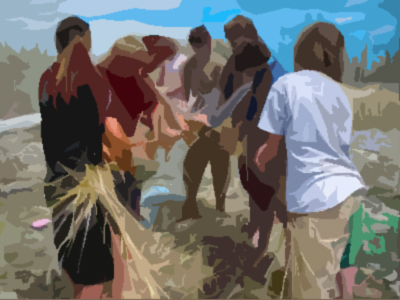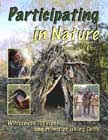A Brain in a Box on a Shelf
The Need to Reconnect Kids with Nature
Published in the Montana Wildlife Federation Newsletter, April/May 2010
and the Bulletin of Primitive Technology, Fall 2011
by Thomas J. Elpel
Seeing my nine-year-old struggle to wrap a rubber band twice around a deck of cards for the first time, I am reminded of the sheer magnitude of all that there is to learn in this world. More than anything, it reminds me that there is no substitute in life for hands-on experience. Our society faces hidden perils as our young people adapt to a world where education and recreation are increasingly electronic and virtual, rather than interactive and authentic. Our young people risk losing an essential connection with physical reality.
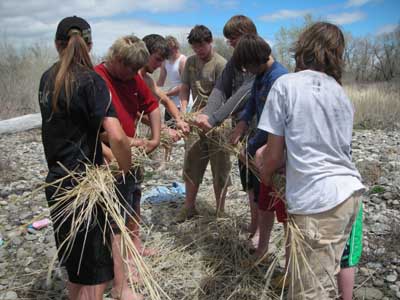 As observed by Frank Wilson, professor of neurology at Stanford University, and quoted by Richard Louv in his book Last Child in the Woods, kids raised on computers don’t understand how the world works. Instructors at medical schools struggle to teach how the heart works like a pump, because “students have so little real world experience; they’ve never siphoned anything, never fixed a car, never worked on a fuel pump, may not even have hooked up a garden hose. For a whole generation of kids, direct experiences in the backyard, in the tool shed, in the fields and woods, has been replaced by indirect learning, through machines. These young people are smart, they grew up with computers, they were supposed to be superior — but now we know something’s missing.” It is kind of like having a brain in a box on a shelf; what good is it if you cannot connect it to the real world and do something with it?
As observed by Frank Wilson, professor of neurology at Stanford University, and quoted by Richard Louv in his book Last Child in the Woods, kids raised on computers don’t understand how the world works. Instructors at medical schools struggle to teach how the heart works like a pump, because “students have so little real world experience; they’ve never siphoned anything, never fixed a car, never worked on a fuel pump, may not even have hooked up a garden hose. For a whole generation of kids, direct experiences in the backyard, in the tool shed, in the fields and woods, has been replaced by indirect learning, through machines. These young people are smart, they grew up with computers, they were supposed to be superior — but now we know something’s missing.” It is kind of like having a brain in a box on a shelf; what good is it if you cannot connect it to the real world and do something with it?
Before the advent of video games, rentable movies, and the internet, kids went outdoors to play. They weren’t just playing ball on manicured lawns, either. They were exploring, building forts, fishing, hunting, playing with fire, climbing trees, and learning. In the process of building a fort, for example, kids learn basic engineering principles. Through trial and error, they learn about the strengths of different materials, how to choose suitable pieces for posts and beams and walls and roofs, as well as how to nail or tie them together.
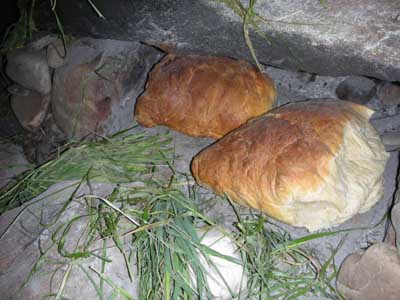 My efforts to reconnect kids with nature began when our own kids were in elementary school in Harrison, Montana. Each year I volunteered to bring their classes out for day-long field trips. We went out in the woods and built shelters, started fires with flint & steel kits, gathered rose hips and herbs for tea, played stalking games, and cooked over the campfire. When my daughters entered junior high, we upped the ante and started doing overnight trips.
My efforts to reconnect kids with nature began when our own kids were in elementary school in Harrison, Montana. Each year I volunteered to bring their classes out for day-long field trips. We went out in the woods and built shelters, started fires with flint & steel kits, gathered rose hips and herbs for tea, played stalking games, and cooked over the campfire. When my daughters entered junior high, we upped the ante and started doing overnight trips.
Our first camping trip could have been our last, after bringing a dozen seventh graders out in the woods without tents or tarps. It rained 1.3 inches in twenty-four hours! Yet, the class stayed adequately dry in shelters they built themselves out of sticks and bark, and everyone had a blast. Eight years later, I am still doing overnight camping trips with junior high kids as well as day trips with younger grades.
We conduct these activities through our business, Outdoor Wilderness Living School – OWLS. Each year we refine the curriculum, creating an immersive, educational experience that runs through every activity from morning to night. Kids learn to start a fire by rubbing sticks together with the bow and drill. They carve their own sets, start a fire, and then use that fire to cook their food. They don’t have dishes, either. They make plates out of tree bark and use twigs as chopsticks. They cook a stir-fry dinner without a metal pan by chopping up meat and veggies on a wooden trough — they cook it by rolling hot rocks around with the food. We also cook bread in a stone oven.
Recreation becomes immersive and educational as well. We teach the kids stalking skills, then turn them loose to attempt swiping a crinkly bag of candy placed in front of a blindfolded student. We provide students with moccasins to help them feel the earth underfoot and teach them to read the language of the birds. They learn how the deer pay attention to the behavior of the birds and how to avoid alarming the birds as they pass through the woods looking for wildlife. The kids learn ancient hunting skills, such as the throwing stick for hunting small game like rabbits, and the atlatl and dart for big game.
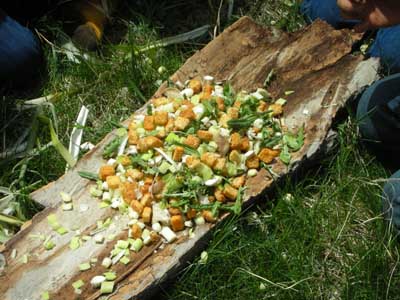 We try to make every activity relevant, so that a skill like plant identification is immersive, rather than academic. A good first step is to introduce edible plants so that the kids taste dandelions, thistles, and cattail shoots, physically internalizing the lesson. But we ran into a problem whenever we gathered a salad and brought it back to camp. It was easy to set the salad aside and forget about it, as everyone reached for ham and cheese sandwiches. To make the lesson fully immersive, we now eat the salad before returning to camp. We cut it up on a slab of bark, add some croutons and salad dressing, and share a big finger salad.
We try to make every activity relevant, so that a skill like plant identification is immersive, rather than academic. A good first step is to introduce edible plants so that the kids taste dandelions, thistles, and cattail shoots, physically internalizing the lesson. But we ran into a problem whenever we gathered a salad and brought it back to camp. It was easy to set the salad aside and forget about it, as everyone reached for ham and cheese sandwiches. To make the lesson fully immersive, we now eat the salad before returning to camp. We cut it up on a slab of bark, add some croutons and salad dressing, and share a big finger salad.
When we cook a stew, the kids make their own bowls, burning a hole into a piece of wood. They naturally apply the same skill to make spoons, even though we don’t introduce the idea ourselves. Sometimes we make ropes out of grass and play tug-o-war in a muddy river channel. We even play a roving game of capture the flag, hunting each other down with marshmallow blowguns. Without words, we try to teach kids that it is possible to have a good time, without the need for electronic gadgets or getting wasted on drugs and alcohol. We documented the junior high camping trip in our newest video, Classroom in the Woods: Primitive Skills for Public Schools.
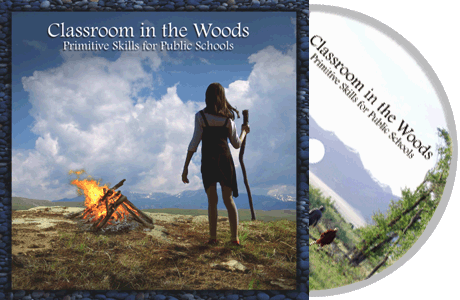 Although our field trips are intensely structured, free play is equally important. As Harrison junior high teacher Linda Ehlers points out, many of these kids have never had the opportunity to throw rocks in the river or learn how to skip stones. These are healthy activities that are sadly missing from the modern world.
Although our field trips are intensely structured, free play is equally important. As Harrison junior high teacher Linda Ehlers points out, many of these kids have never had the opportunity to throw rocks in the river or learn how to skip stones. These are healthy activities that are sadly missing from the modern world.
The educational component of hanging out in the woods may not be obvious, but it can be profound. For example, being around a campfire may not seem educational, yet kids are learning. They may not grasp the scientific model detailing the interplay of fuel, heat and oxygen, but they absorb the science experientially, adding or removing fuel, or blowing on a fire to make it burn better.
The lack of this type of experience is evident in kids and adults who wonder why a big stick won’t ignite with the flame from a single match. They have no concept of basic physics. In a culture where people are increasingly detached from the natural world, it is increasingly common to see printed warnings for things that should be plainly obvious, such as coffee cups that say “Caution: Contents may be hot.”
Other people ask the most bizarre questions, such as tourists in Yellowstone National Park who wonder, “Where do they put all the animals at night?” They simply have no concept of reality. As a society, how can we function that way? How can voters make sound choices at the polls when they are not connected to the most basic things, such as where the electricity comes from when they flip on a light switch?
Without a connection to physical reality, energy consumption and policy proposals are abstract and meaningless. Just as the national deficit is too big to grasp — and rapidly growing bigger as the numbers become more imaginary — it is impossible to chart a sustainable energy future when energy itself is an abstraction.
Real world experiences help “wire the hands to the brain,” enabling people to integrate conceptual knowledge, while acquiring an ethic of stewardship and the tools to think sustainably. Managing a campfire provides the necessary foundation for people to intuitively quantify energy and understand where it comes from.
I’ve seen the work of professors with lots of credentials behind their names who have crunched the numbers and “proved” that it is impossible to create a sustainable society. We will just hum along consuming all the resources on the planet until we crash and burn. And yet, I know from hands-on experience that it is not difficult to live sustainably. After spending thousands of hours out in the wilds building shelters and trying to survive without a blanket, I graduated to building a passive solar stone and log home with photovoltaic panels that run the meter backwards to generate as much electricity as we use. And by building our house without a thermostat or furnace, I became highly aware of energy leaks and the amount of fuel — fire wood — it takes to make up for inefficiencies in house design.
Recognizing that it is not sustainable to replace all fossil fuels with firewood, I have continued refining the building process, learning to build low-cost houses from mostly secondhand materials that need little, if any, supplementary heat. This knowledge is gained experientially, by trying ideas to see what works.
The underlying message is that, in order to create a sustainable society, we need to reconnect young people with the real world. Our educational institutions are highly focused on mental learning, especially the regurgitation of facts and figures and the ability to complete complex calculations. It is easy to measure this kind of learning progress through written tests, but it doesn’t mean anything if it is not connected to physical reality.
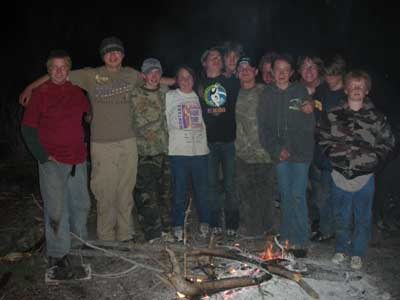 Nationwide, schools are struggling to cope with poor academic performance, often jettisoning arts and shop programs to emphasize reading, writing, and arithmetic skills. But trying to reinforce mental learning in a world where kids are already confined to a mental existence is a bit like trying to cure a sunburn by laying out in the sun long enough to gain immunity. Emphasizing academic skills made sense when young people grew up farming, ranching, hunting, fishing, or building forts and working on cars. But now we need to create balance by actively reconnecting kids with direct, physical experience.
Nationwide, schools are struggling to cope with poor academic performance, often jettisoning arts and shop programs to emphasize reading, writing, and arithmetic skills. But trying to reinforce mental learning in a world where kids are already confined to a mental existence is a bit like trying to cure a sunburn by laying out in the sun long enough to gain immunity. Emphasizing academic skills made sense when young people grew up farming, ranching, hunting, fishing, or building forts and working on cars. But now we need to create balance by actively reconnecting kids with direct, physical experience.
I constantly hear reports back from the local school that the kids talk about the junior high camping trip all year long, and reminisce about it throughout high school. Upon graduation, some have described the outing as the most memorable experience of their lives. That is not a testament to the quality of our program, so much as it is a testament to what is missing from the daily lives of nearly every child in America. Playing video games or hanging out at the mall doesn’t make much of a memory. But surviving a torrential downpour with nothing but sticks and bark for protection, or sleeping in a pile of grass without a sleeping bag for warmth — that makes memories that last a lifetime.
Thomas J. Elpel is the author of Participating in Nature, Botany in a Day, and producer of the Art of Nothing Wilderness Survival Video Series. In addition to Outdoor Wilderness Living School – OWLS, Tom is the founder of Green University®, LLC and the Jefferson River Canoe Trail.
 See our DVD: Classroom in the Woods Primitive Skills for Public Schools |
|
Go to Books and Videos by Thomas J. Elpel
Return to the Primitive Living Skills Page.
Return to Thomas J. Elpel’s
Web World Portal | Web World Tunnel
Thomas J. Elpel’s Web World Pages
About Tom | Green University®, LLC
HOPS Press, LLC | Dirt Cheap Builder Books
Primitive Living Skills | Outdoor Wilderness Living School, LLC
Wildflowers & Weeds | Jefferson River Canoe Trail
Roadmap To Reality | What’s New?
© 1997 – 2019 Thomas J. Elpel
Come Follow Us on Twitter – Come Like Us on Facebook
Check us out on Instagram – And Sign Up for our Newsletter



